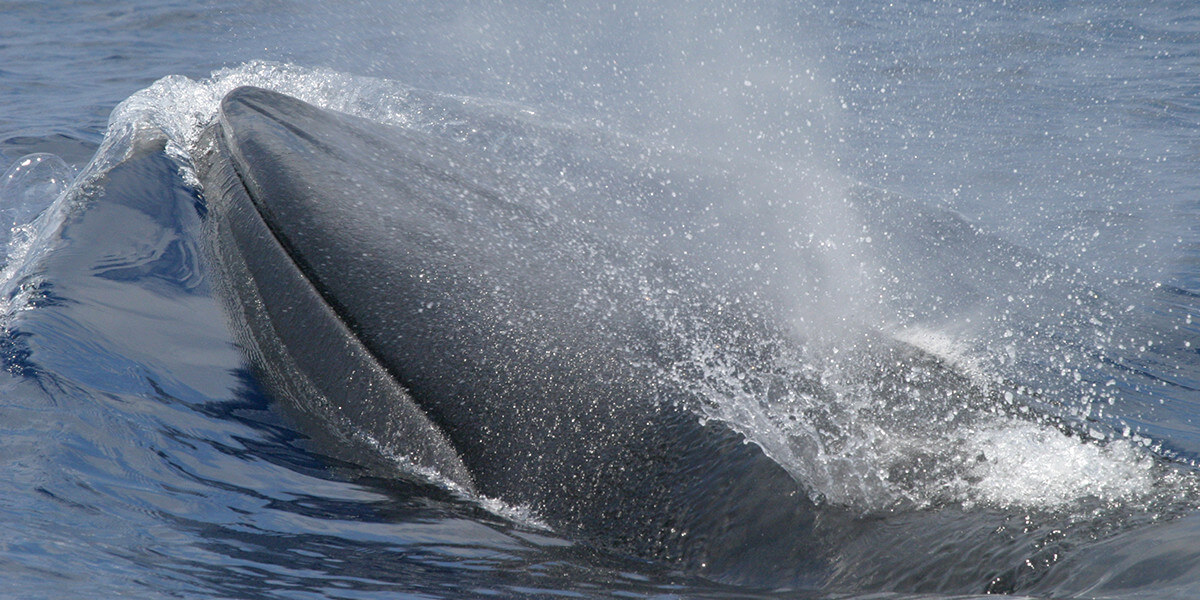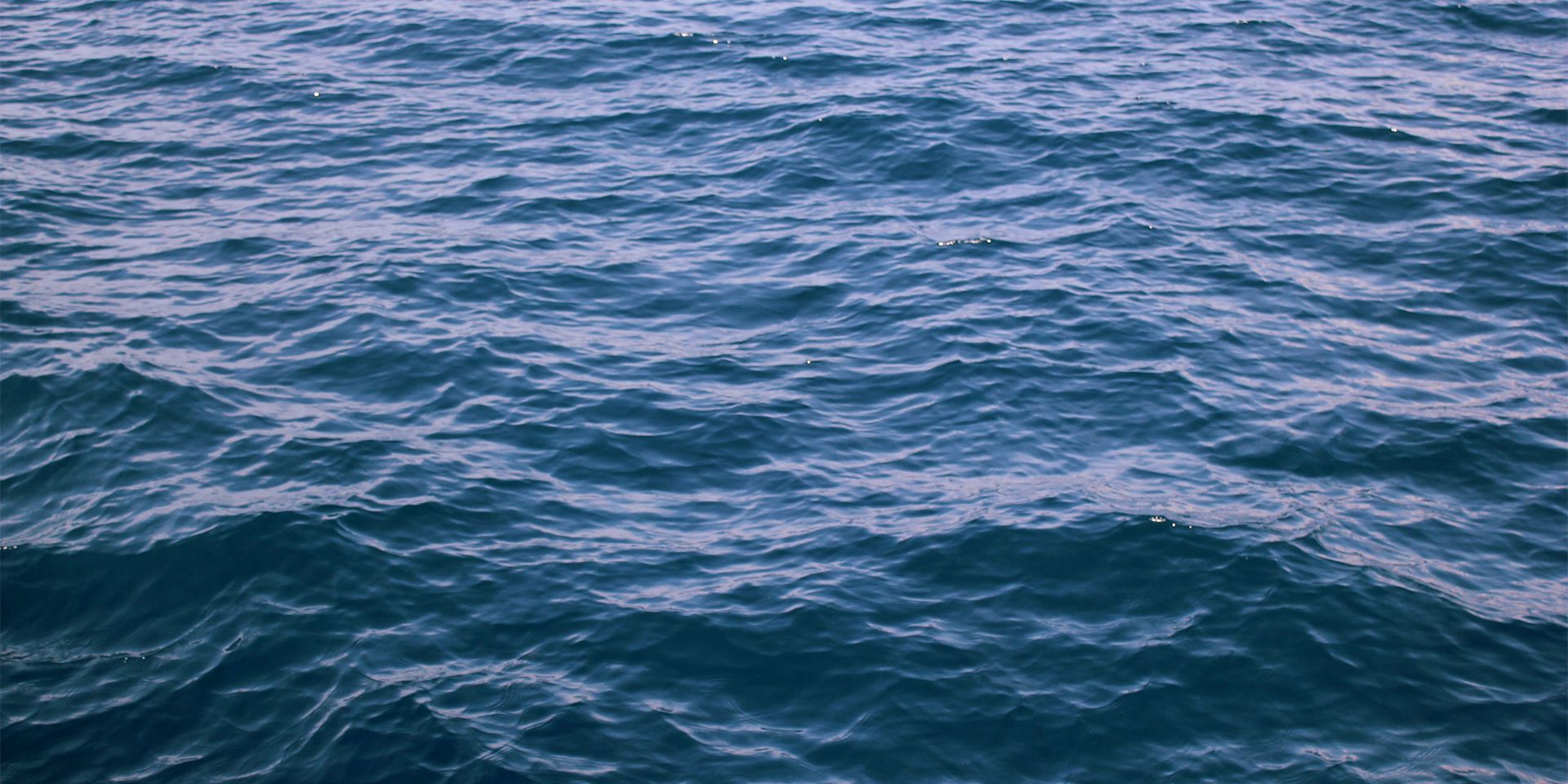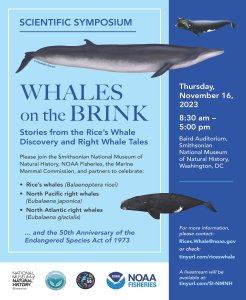Rice's Whale
In 2021, the Rice’s whale was recognized as a new species, evolutionarily distinct from other Bryde’s whales around the world. Rice’s whale is the only year-round resident baleen whale in the Gulf of America (formerly the Gulf of Mexico). At an estimated population size of only 51 animals, it is one of the world’s most endangered baleen whales. Rice’s whales are found primarily between 100 and 400 meters water depth. The whales occur primarily in the northeastern Gulf, in what is referred to as the species’ core distribution area, but there has also been a confirmed sighting and regular acoustic detections of Rice’s whales in the western Gulf.

Rice's whale (formerly Bryde's whale). Photo taken under NOAA research permit #779-1633. (NOAA)
Species Status
First recognized in the Gulf in 1965, Rice’s whales were assumed to be a part of the broadly distributed Bryde’s whale complex which occurs in tropical and subtropical waters of the Atlantic, Pacific, and Indian Oceans. After many other large whale species became depleted by commercial whaling, whalers began targeting Bryde’s whales in the 1900’s. Between 1911 and 1987, over 30,000 Bryde’s whales were killed worldwide by commercial whalers.
Genetic analyses recently determined that the Gulf population is distinct from other Bryde’s whale populations. Based on genetics analyses and new morphological information, scientists have recognized this population of Bryde’s whale as a new species, with the name Rice’s whale (Balaenoptera ricei). The common name and species name honors the renowned cetologist Dale W. Rice, who, in 1965, was the first researcher to recognize that Bryde’s whales are present in the Gulf. The name ‘Gulf of Mexico whale‘ has also been suggested for this species.
The population size of the Rice’s whale is estimated to number only 51 individuals, and are one of the most critically endangered large whales in the world. They occur primarily in the northeastern Gulf, along the shelf break in waters between 100 and 400 meters deep within the De Soto Canyon region off the Florida Panhandle, but visual and acoustic surveys have also confirmed their presence in the western Gulf, recently as far south as Mexico. Spatial density models suggest that suitable habitat is available for Rice’s whales in the entire Gulf in the 100 to 400m depth range.
Rice’s whales are threatened by vessel strikes, acoustic disturbance from seismic airguns and other oil and gas-related activities, military training activities, vessel noise, entanglement in commercial fishing and aquaculture gear, marine debris, and pollution from agricultural runoff and oil spills in the Gulf.
A petition to list the northern Gulf stock of Bryde’s whale (i.e., Rice’s whale) as endangered under the Endangered Species Act (ESA) was submitted to the National Marine Fisheries Service (NMFS) in 2014. NMFS subsequently initiated a status review of Bryde’s whales under the ESA, which was finalized in December 2016. The status review determined that the Gulf Bryde’s whale is taxonomically a subspecies of the Bryde’s whale complex, thus meeting the ESA’s definition of a species. Based on the small population (likely fewer than 100 individuals), its life history characteristics, its extremely limited distribution, and its vulnerability to existing threats, NMFS determined that this population of whales is in danger of extinction throughout all of its range. In April 2019, NMFS listed the Gulf of Mexico Bryde’s whale as endangered.
NMFS published a final rule establishing the name change from Bryde’s whale (Gulf of Mexico subspecies) to Rice’s whale under the ESA in August 2021. The immediate next steps are the development of a recovery plan and designation of critical habitat under the ESA. In the interim, NMFS has prepared a guidance document to direct recovery efforts for the Rice’s whale until a recovery plan has been developed.
In the Fall of 2021, NMFS held a series of recovery planning workshops to seek input from experts and stakeholders on (1) approaches for recovery planning that address the challenges relevant to the recovery of the listed species in its current and foreseeable environment; (2) development of possible recovery criteria that would indicate when the species should be considered for delisting; and (3) development of suggested recovery actions to reduce and/or ameliorate the threats to these listed whales. A summary of the recovery planning workshops is now available.
In July 2023, NMFS proposed to designate critical habitat for Rice’s whale in the northern Gulf. NMFS identified the following feature as essential to the conservation of Rice’s whale: Gulf continental shelf and slope waters from 100 m to 400 m deep that support individual growth, reproduction, and development, social behavior, and overall population growth. This feature has the following attributes that support Rice’s whales’ ability to forage, develop, communicate, reproduce, rear calves, and migrate:
- Sufficient density, quality, abundance, and accessibility of small demersal and vertically migrating prey species, including scombriformes, stomiiformes, myctophiformes, and myopsida;
- Marine water with (i) elevated productivity, (ii) bottom temperatures of 10–19 degrees Celsius, and (iii) levels of pollutants that do not preclude or inhibit any demographic function; and
- Sufficiently quiet conditions for normal use and occupancy, including intraspecific communication, navigation, and detection of prey, predators, and other threats.
Comments on the proposed critical habitat designation were due to NMFS by October 6, 2023. NMFS is currently reviewing comments before issuing a final critical habitat designation.
What the Commission Is Doing
The Marine Mammal Commission is working with NMFS and other partners in the Gulf to expand research and monitoring efforts for all marine mammals.
The Commission recently partnered with the Smithsonian Institution and NMFS to raise awareness regarding Rice’s whales. A special symposium focused on Rice’s Whales and other endangered large whales, “Whales on the Brink“, was convened on November 16, 2023, at the Smithsonian National Museum of Natural History, as part of the 50th Anniversary Celebration of the Endangered Species Act. The symposium followed the Commission’s 2023 Annual Meeting, which was held November 14-15, 2023 at the Navy Memorial Visitor’s Center in Washington, D.C.
The Commission regularly contributes guidance and input to NMFS on its deployment of acoustic recorders around the Gulf, including in Mexican waters, to detect the presence and seasonal distribution of Rice’s whales and other offshore marine mammals and to understand the various sources and sound levels associated with human activities in the Gulf. More about passive acoustic research being conducted by NMFS and its partners, including the Long-Term Investigations into Soundscapes, Trends, Ecology, and Noise in the Gulf of Mexico (LISTEN GoMex) project, can be found on the NMFS Southeast Fisheries Science Center’s Passive Acoustic Research webpage.
The Commission submitted comments in July 2023 in support of a petition to establish vessel speed and other vessel-related measures to protect Rice’s whales. However, NMFS denied the petition in October 2023, citing the need to focus on other high priority conservation actions including finalizing critical habitat for the species, conducting additional vessel risk assessments, and developing a recovery plan for the species. The Commission also submitted comments on NMFS’s proposal to designate critical habitat for Rice’s whales. A decision on that action is still pending.
Commission staff recently served on a NMFS Steering Committee to convene experts and stakeholders in a series of workshops to identify recovery criteria and recovery actions for the Rice’s whale, as part of NMFS’s recovery planning efforts. Those workshops were held in October and November of 2021, and a summary of the workshops is now available.
Commission staff also served as one of two technical monitors on a RESTORE Act Science Program-funded project to evaluate Trophic Interactions and Habitat Requirements of Gulf of Mexico Rice’s Whales. The NMFS Southeast Fisheries Science Center, along with its partners from Florida International University and Scripps Institution of Ocenography, conducted the project from 2017 to 2021. The shipboard surveys conducted visual sightings, passive acoustic monitoring, tagging, prey characterization from echosounders and net tows, and the collection of biological samples. The field work focused on habitat characterization in the eastern Gulf. Outcomes included an improved understanding of population status, identification of habitat features and characteristics, and a better understanding of the risk of exposure to human activities. A video presentation summarizing research from the RESTORE Science Program is available on the project website, along with additional information about the project.
In April 2015, the Commission held a meeting to identify high priority, overarching data needs and to identify potential funding sources and opportunities for expanding marine mammal research and monitoring in the Gulf. Presentations and a summary of the meeting are available here.
Commission Reports and Publications
Gulf of Mexico Marine Mammal Research and Monitoring Meeting Summary (Marine Mammal Commission 2015)
Assessing the Long-term Effects of the BP Deepwater Horizon Oil Spill on Marine Mammals in the Gulf of Mexico: A Statement of Research Needs (Marine Mammal Commission 2011)
Commission Letters
| Letter Date | Letter Description |
|---|---|
| September 28, 2023 | Letter to NMFS on its proposed critical habitat for Rice’s whales. |
| July 21, 2023 | Letter to BOEM on its FY2024-25 Environmental Studies Program Studies Development Plan. |
| July 6, 2023 | |
| February 9, 2022 | |
| December 16, 2021 | |
| December 10, 2021 | |
| May 5, 2021 | |
| December 9, 2020 | |
| July 15, 2019 | |
| February 4, 2019 | |
| October 31, 2018 | |
| August 21, 2018 | |
| February 6, 2017 | |
| December 4, 2015 | |
| September 28, 2015 | |
| July 9, 2013 | |
| July 8, 2013 | |
| December 28, 2012 |
Learn More
Threats
The Rice’s whale is threatened by vessel strikes, acoustic disturbance from seismic airguns and other oil and gas-related activities, military activities, entanglement in fishing gear and aquaculture nets, marine debris, vessel noise, oil spills, and pollution.
Rice’s whale sightings and strandings are rare, but on 29 January 2019, a 38-foot male stranded in the Florida Everglades. A necropsy of the whale determined that it was underweight, and an examination of its stomach revealed a piece of hard plastic, approximately 5 cm by 7.5 cm in size. The plastic piece had sliced through part of the whale’s stomach, which likely contributed to its death. That whale’s skeleton is now at the Smithsonian Institution in Washington, D.C., and it represents the holotype for the new species.
Current Conservation Efforts
NMFS scientists are in the process of analyzing data recently collected on the abundance, distribution, diet, behavior, and habitat use of Rice’s whales in the Gulf of Mexico. The data, presented at a series of expert workshops convened in October and November 2021, are helping to identify recovery criteria and recovery actions for the Rice’s whale as part of NMFS’s recovery planning efforts to conserve and protect this stock from natural and human-caused threats. These data will also assist in efforts to designate critical habitat for the species under the ESA, and to help update Rice’s whale Biologically Important Areas.
The Future/Next Steps
Actions will be needed to ensure that energy development, fishing, aquaculture, shipping, and other potentially harmful activities are prevented from expanding into Rice’s whale core habitat areas. NMFS is conducting extensive passive acoustic monitoring throughout the Gulf of Mexico to determine, among other objectives, the extent to which Rice’s whales occur in areas beyond the core habitat identified in the eastern Gulf. Continued visual and acoustic surveys, biological sampling, and trophic studies are needed to understand Rice’s whale foraging and diving behavior, prey preferences and availability, and the potential effects of climate change on this endangered species.
Additional Resources
NMFS Rice’s Whale Species Page
Rice’s Whale Recovery Planning (April 2022)
Trophic Interactions and Habitat Requirements of Gulf of Mexico Rice’s Whales (March 2022)
NMFS New Species of Baleen Whale in the Gulf of Mexico (January 2021)
NMFS Discovering a New Species of Whale (video)
NMFS 2022 Stock Assessment Report for Rice’s Whale (May 2023)
NMFS Rice’s Whale Core Distribution Area Map and GIS Data (2019)

